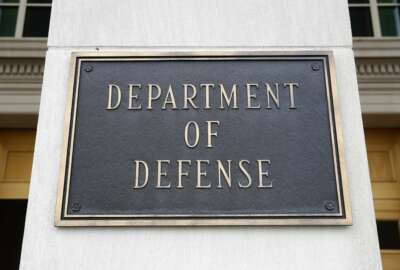Even indirect military support of Ukraine will cost the US Money
The United States may not be a war with Russia in the classic military sense. But it does have troops deployed to NATO countries. And that costs money.
Best listening experience is on Chrome, Firefox or Safari. Subscribe to Federal Drive’s daily audio interviews on Apple Podcasts or PodcastOne.
The United States may not be a war with Russia in the classic military sense. But it does have troops deployed to NATO countries. And that costs money. For a view into contract spending to support troops in NATO countries, the Federal Drive with Tom Temin turns to Bloomberg Government senior data analyst Paul Murphy.
Interview transcript:
Tom Temin: Paul, good to have you back.
Paul Murphy: Pleasure to be with you, Tom.
Tom Temin: So I guess 82nd Airborne and other U.S. units are standing by for whatever purpose in some of the NATO countries, Poland, what does this cost? What are some of the needs they have that reflect themselves in spending?
Paul Murphy: Well, Tom, we noticed from studying contract spending in Afghanistan, that the total amount of spending corresponded fairly closely with the number of troops deployed, and as the number of troops went down, spending went way down. So we thought we would do another similar analysis with NATO spending. So we pulled some data down from the Defense Manpower Data Center, we found that active duty troops and reserves and civilian DoD personnel totaled about 82,700 in fiscal 2021. And that was up about 3%, over the last seven years since Russia invaded Crimea back in 2014.
So there’s been a general increment in the number of deployed personnel, including the DoD and civilian. We also noticed over the same period that spending went up, it’s up around 5.4 billion in the 28 European NATO countries, and it’s up 18.5%, it’s chugging along at about $5.1 billion per year. So what that means is the ratio of dollars to troops is about $63,000 per person, DoD and civilian per year. That’s the average overall for the seven years, $63,000. So if we take the 7,000 troop figure that President Biden proposed to augment the U.S. NATO forces that was announced last week, adds up to roughly 440 million more dollars, we might expect in contract support for troops deployed in NATO, European countries in the coming months and years.
Tom Temin: And what costs to have people, because their salaries and so forth are already taken care of. And what is the spending go for?
Paul Murphy: Well, the contract spending is obligation. So it’s not outlays. It’s not military assistance, like we’re hearing about being sent to Ukraine. It’s not spending by civilian agency, State and USAID, we have a presence here. This is contract obligations. And it’s being spent mainly on four markets. We’ve got 38% of the money being spent for facilities and construction, not surprisingly. About 23% for transportation and logistics, 10% for IT and 9% for professional services. That’s a four out of every five dollars in just those four markets.
Tom Temin: And to whom does these obligations go? Are they local, foreign based contractors?
Paul Murphy: Largely, I mean, there’s a few American companies that stand out, for instance, the biggest American companies working in NATO countries right now include KBR, have a big presence in Poland and Khaki and Amentum in Germany. And Amentum, of course, is so locally based here in Germantown, Maryland. But a lot of the money goes for utilities, electric and local services that are paid for through foreign companies in the foreign countries.
Tom Temin: We’re speaking with Paul Murphy, senior data analyst at Bloomberg Government, and this is appropriated money, I mean, there’s no such thing as an overseas contingency operation budget anymore. So what are the accounts that these come from?
Paul Murphy: I think it’s largely operations and maintenance budgets. And I think that, you know, we’re gonna see a general trend upward if the troop numbers increase.
Tom Temin: And now, of course, the president has promised, we’re not going to be fighting with Russia, we don’t have a war with Russia. I hope that we don’t. When we had wars with countries or actual kinetic activity by our military, then the cost goes up exponentially, doesn’t it?
Paul Murphy: It could, it really depends on the nature of the conflict. And if we are in direct hostilities with these foreign countries, I think something to watch for that this playing out now is the amount of money we actually spend on IT, and particularly cybersecurity in the coming months, because Russia is known to be hacking and attacking countries with cyber threats throughout Eastern Europe. And U.S. is dedicated to supporting countries in the cyber threats as well as the security threats.
Tom Temin: And have we seen that happen yet? The increase in cyber spending? Or is it just a potential at this point?
Paul Murphy: I think it’s right now potential. As I say it’s been chugging along, the total has been chugging along at about 5.1 billion per year. And as threats emerge, the spending evolves. But we may see more information technology spending in particular now as a result of the nature of the shots.
Tom Temin: But getting back to that cost of keeping troops outside of where they’re normally housed. In this case in the 28 NATO countries as a result of the Ukraine situation, $63,000 per head over seven years. That doesn’t sound like much.
Paul Murphy: There have been efficiency moves in Europe. There’s been a base consolidation initiative since 2015. So there have been attempts to try and moderate spending and make it as efficient as possible. But you know, again, depending on the nature of the sport the United States gives, we could see a ramp up in contract spending commensurate with an increase in personnel.
Tom Temin: And what about civilian personnel that might be moved or somehow placed elsewhere for the duration of something? Does that come up? Is that visible? That kind of spending?
Paul Murphy: We haven’t looked at that explicitly, we were looking at DoD civilian personnel. So these would be people attached, particularly to bases providing administrative support, operational support at the bases and not involved in direct hostilities.
Tom Temin: And of the 28 countries, where is most of the spending happening?
Paul Murphy: Most of it, not surprisingly, is occurring in Germany, about 2.6 billion in fiscal 2021, followed by the U.K. at 720 million and Italy, where we have big naval presence of 450 million.
Tom Temin: And that could change though as more people move, say east.
Paul Murphy: Absolutely. And also change in response to the nature of the threat being addressed. And there’s talk about moving a Stryker Brigade, for instance, into Romania and making it a permanent presence. And so with the Stryker armored vehicles is going to come, you need for support, maintenance training, other forms of logistics.
Tom Temin: Paul Murphy is senior data analyst at Bloomberg Government, thanks so much.
Paul Murphy: Thank you, Tom. Pleasure to be with you.
Copyright © 2025 Federal News Network. All rights reserved. This website is not intended for users located within the European Economic Area.
Tom Temin is host of the Federal Drive and has been providing insight on federal technology and management issues for more than 30 years.
Follow @tteminWFED






